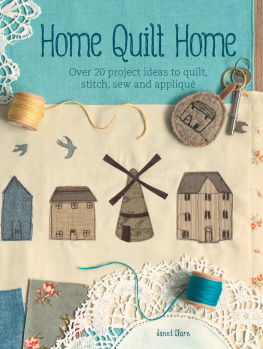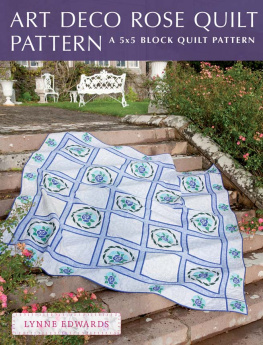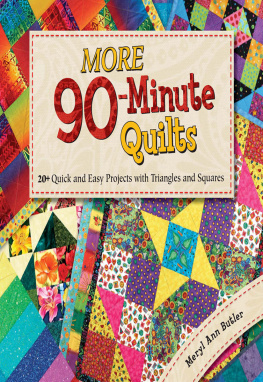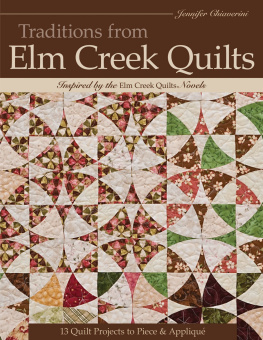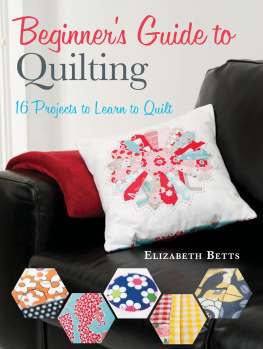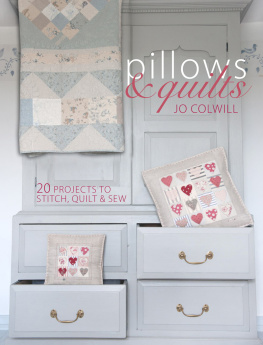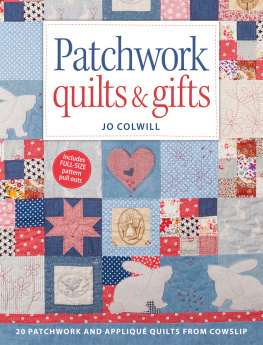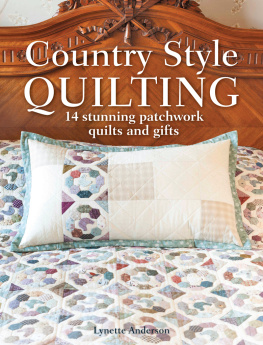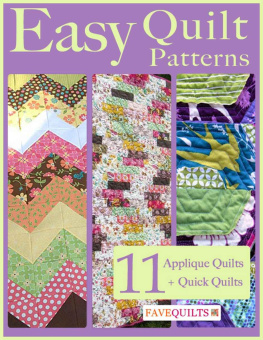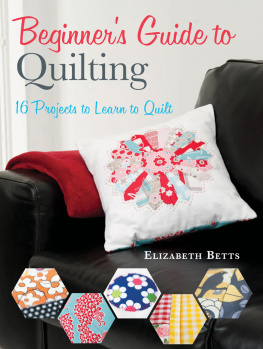Contents
Welcome
Home
A valued place offering security and happiness, regarded as a refuge or place of origin.
I love houses. I love everything about them from looking around friends homes, visiting stately mansions on holiday, and browsing the estate agents windows in town, to walking around villages admiring the pretty cottages. I love them because houses very quietly but eloquently tell the story of who lives there, and I really find that fascinating.
So, researching and creating this book full of houses and quilts, which are two of my very favourite things, has been a real treat. I spent days daydreaming about living in lighthouses, what winters would be like living in windswept cottages on the moors or leading a busy life bustling about in a neat town house. I could spend an hour looking at mansions online and call it research and daydream to my hearts content whilst drawing a row of beach huts.
I had such fun and I think it shows. I hope Ive created a happy and warm book full of projects youll enjoy making as much as I did. Please feel free to use my designs as starting points, to mix and match the templates, to add more colour, to change the scale everything is versatile. Make the quilt you want to make.
And yes, these quilts will take you hours to make, but they will all be happy ones. And wheres the hurry anyway? Enjoy the process: put on your favourite songs, make a cup of tea and just be glad to be creating. All the hours you invest in creating these textile treasures will not be wasted you will see and feel them every time you enjoy using what you have made. You will remember where you sat and embroidered, the dress the patch came from, laughing whilst stitching the binding on. Youre not only making a quilt, you are piecing memories together too, which will add comfort to any room even those far from home.
Ive never met a single soul who on being given a quilt complained about a wonky hem or a mismatched seam so please stop pointing out all your little sewing mistakes. You know you do it! Simply smile and accept the compliments graciously. Remember, you have created a quilt full of warmth, colour, texture and comfort and the rest can safely be forgotten.
And lastly, please dont keep your quilts for best. Every quilt aspires to be well-worn, frayed, faded and loved. So use them, wash them, build dens with them, take them on picnics, sleep under them, wrap up and watch the sunset in them, put your babies on them, spill wine on them. Really live with your quilts and they will absorb the very essence of your home and life. If the stitching comes undone stitch it back together or add a patch to it. Think of it as adding another memory.
It has been a real pleasure creating this book and Id like to thank you for your kind interest in my work. I hope I have inspired you to create a house-filled quilt for your home. Remember, whether youre in the town, country or at the coast, you are always at home with a quilt.
Tools and Materials
We all have our favourite pieces of equipment and this short section describes the items I use most. See the section for advice on the methods used to make and finish off the projects.
Measurements
All of the projects in this book were made using Imperial inches and although metric conversions have been given in brackets the most accurate results will be obtained using inches.
Rulers and Rotary Cutters
Traditionally, quilters cut their fabric with scissors and of course you can still do that if you wish. I do still use a tape measure and ruler from time to time. However, using a rotary cutter, a self-healing cutting mat and a large acrylic ruler will increase your speed and accuracy when cutting and measuring fabric.
Scissors
You will need at least a couple of pairs of scissors a large pair for cutting lengths of fabric and a small, sharp pair for cutting out small details and fiddly bits. I also keep a pair of scissors just for paper and cutting fusible web.
Pins and Needles
Quilters are surprisingly fussy about the pins they use! I like to use Clover flat-headed pins, which are very sharp and long. You can also use them with your quilters ruler and rotary cutter as they lay completely flat in the fabric. You will find it useful to have a wide range of sewing and quilting needles. Im not loyal to any brand, but I like them to be sharp so I replace them regularly. If you keep your pins and needles in a pincushion filled with sand it helps to keep them sharp.
Machine Needles
You need a new, very sharp needle for free-machine stitching. Did you know youre supposed to change your sewing machine needle after every five hours of sewing time? For my work I use denim needles (size 80/12), which have sharp points and a strong shank designed for stitching through many layers of fabric.
Safety Pins
I use curved safety pins to keep my quilt layers together whilst I am quilting them. You will need a surprisingly large number of them.
Iron and Ironing Board
Quilters iron, or more accurately press, their fabric constantly. Funnily enough this sort of ironing is not a chore, whereas doing the work shirts really is! Some quilters prefer to use a dry iron, but Im happy to use my steam iron.
Sewing Machine
I use Pfaff sewing machines. I have a Quilt Expression 4.0 and a slightly more basic 2044. If you are looking for a new sewing machine for quilting you would do well to look for one with a long and high throat, which allows plenty of room for your quilt roll when you are machine quilting. You will also want to be able to lower the feed dogs and have a darning foot attachment. Anything else is an asset but not essential for my patchwork and quilting techniques.
Marking Tools
There are lots of marking tools available. I mainly use a water-soluble fabric pen but you could use a pencil for light fabrics or chalk for dark fabrics.
Threads
I prefer to use a Gtermann polyester thread for my free-machine drawing technique. Polyester does not snap or fray as readily as cotton thread, so it is much kinder to you when you are drawing with your sewing machine. I dont like black as I feel it has a deadening effect so I use a deep charcoal (shade 701) for most of my free-machine drawing. For piecing I like shade 633, which is a neutral dust colour.
Fabrics
Traditionally, quilters saved and used any scrap of fabric they could find, and I think that is still a lovely way to create quilts. Gather good quality wool, cotton and linen fabrics from charity shops (thrift stores). If you pretend they are a haberdashery store you will look at their rails very differently buttons can be cut off shirts, ties are beautifully printed silk simply shop with your imagination! It is perhaps more practical, however, to buy 100% cotton patchwork fabric, which comes in thousands of wonderful designs and colour coordinated collections and is of excellent quality.
Fabric stash
Every real quilter has a bigger fabric stash than they care to admit to! I keep even the smallest scrap too, as they might come in handy one day. Ive given up trying to organize my fabric I just throw it in drawers and boxes and hope for the best!
Right sides and wrong sides
The right side of the fabric is the one where the pretty design looks the best. However, I often use the wrong side to create muted colours and tonal effects in my quilts. If you use the front and the back of a print in the same quilt it will look aged and vintage.

